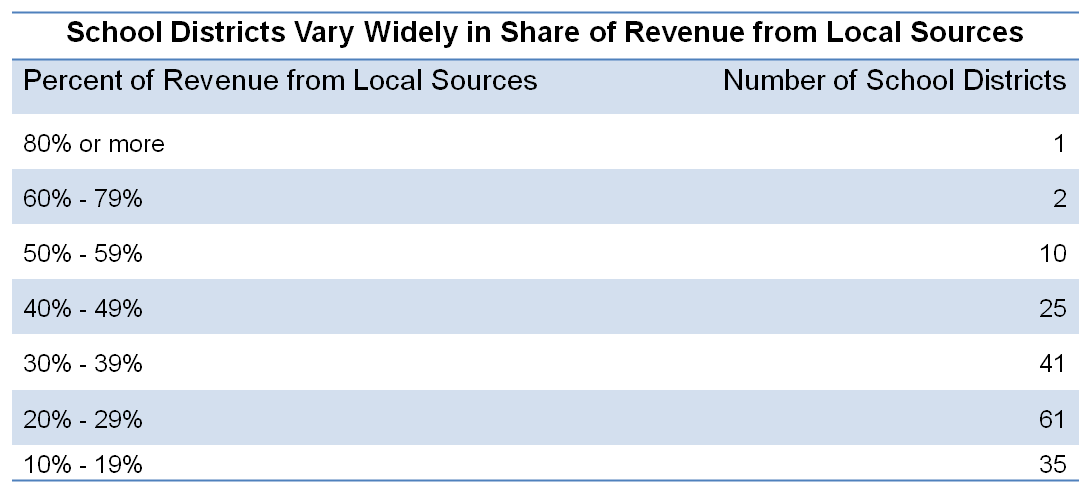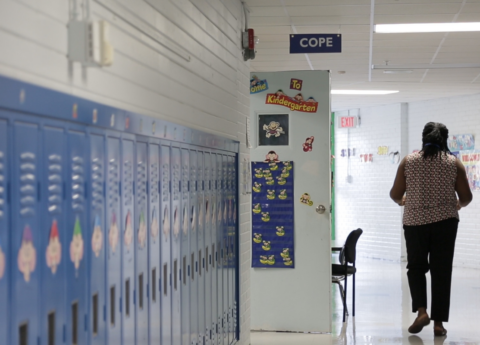Cuts to state and federal funding for education are leading to greater reliance on local revenue sources and exacerbating funding inequity between school districts, as described in a Louisville Courier-Journal story today.
Less reliance on state and federal money means a growing gap in resources due to the way in which schools are funded. Each district relies on a mix of federal, state and local dollars. For Kentucky as a whole, 46 percent of school funding is from the state, 39 percent is from local revenue and 14 percent from the federal government.
But the mix differs greatly depending on local wealth in districts; poorer districts rely more on state and federal funding than do wealthy districts. At the state level, SEEK (the main formula used to allocate monies to local schools) gives greater revenues to those localities less able to generate local dollars given the same tax effort. The table below shows the variation in reliance on local funds. Only 12 percent of the Wolfe County school district’s funding comes from local revenues, whereas 84 percent of funding for Anchorage Independent (located in suburban Jefferson County) comes from local sources.
Source: KCEP analysis of Kentucky Department of Education data
State funding through the SEEK formula has been basically flat since 2008, but is down 9.9 percent over that time period after accounting for inflation and growth in student enrollment. State funding for other areas like textbooks, professional development and afterschool services are down 39.5 percent even before taking inflation and student population growth into account.
As the Courier-Journal story points out, many districts have responded to the cuts by raising local taxes. But school districts in faster-growing counties can generate more new revenue than those in slow-growing counties for the same tax increase.
Districts also vary widely in their reliance on federal dollars. 36 percent of Owsley County’s funds come from federal sources, whereas only 2 percent of Anchorage Independent’s monies come from the federal government. Poorer districts also get more in per-pupil dollars than richer districts do. Owsley County received $4,978 per student in federal money in 2013 while Beechwood Independent in Kenton County received $400. That’s because a large portion of federal K-12 education monies are for two areas that help poorer districts more: Title 1 programs that serve students from disadvantaged backgrounds and special education.
Federal budget cuts through the Budget Control Act (including sequestration) are slicing funding for those programs. After adjusting for inflation, there’s 12 percent less in Title 1 money in 2013 than there was in 2010 and 11 percent less in special education funds.
The gap between rich and poor school districts has been widening gradually in recent years. In 1990, the state greatly narrowed the gap by creating SEEK as part of the Kentucky Education Reform Act (KERA). KERA was the legislature’s response to the 1989 Kentucky Supreme Court decision declaring the entire state school system unconstitutional in part because of funding inequity. As the graph below shows, the gap between rich and poor districts has been slowly growing after dropping dramatically right after SEEK was created. The difference in per pupil state and local spending between the richest 20 percent of school districts and the poorest 20 percent of districts is 40 percent higher in 2010 than it was in 2000.
Source: Office of Education Accountability 2011 School Finance Report
Cuts to school funding don’t just harm the adequacy of resources to provide quality education. They also undermine the goal of equal opportunity for every child.






